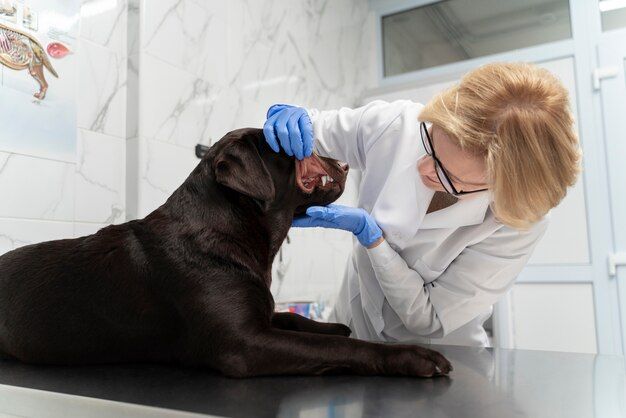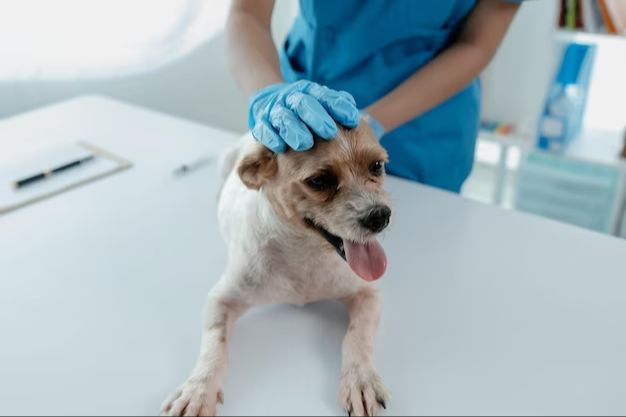Introduction
Cancer is unfortunately very common in dogs, just as it is in humans. Dogs can develop a wide range of cancers that can impact their health and quality of life. Some of the most frequently diagnosed dog cancers include lymphoma, mast cell tumors, hemangiosarcoma, osteosarcoma, and mammary gland tumors.
For dog owners, a cancer diagnosis in their beloved pet can be emotionally devastating. Understanding the common cancers in dogs, available treatments, and prognosis can help owners make the best decisions for their dog’s care and comfort. While some dog cancers like lymphoma and osteosarcoma are aggressive and have poorer outcomes, others like mast cell tumors can often be successfully treated if caught early.
The good news is that as veterinary medicine continues to advance, there are better treatment options available for dogs with cancer. While caring for a dog with cancer takes commitment and often significant expense, most owners are willing to do whatever they can to help their dog live a good quality life for as long as possible. With treatment and care, many dogs can survive and continue enjoying time with their families even after a cancer diagnosis.
Cancer Rates in Dogs

Cancer is unfortunately very common in dogs. According to the Animal Cancer Foundation, about 1 in 4 dogs will develop cancer at some point in their lifetime. Dogs can develop cancer at any age, but it becomes more likely as they grow older. The median age for a cancer diagnosis is about 10 years old.
Certain breeds of dogs are at higher risk for specific types of cancer. For example, Boxers and Boston Terriers are prone to mast cell tumors. Golden Retrievers have high rates of lymphoma, hemangiosarcoma, and osteosarcoma. Rottweilers, Scottish Terriers, and Shetland Sheepdogs are more likely to develop bladder cancer. It’s important for owners of high-risk breeds to be vigilant about cancer screening.
Gender can also play a role in cancer susceptibility. Unspayed female dogs have a greater chance of mammary tumors and other hormone-related cancers. Male dogs have higher rates of lymphoma, prostate cancer, and other testosterone-dependent cancers. Neutering or spaying can reduce certain cancer risks.
While any dog can develop cancer, being aware of risk factors like age, breed, and gender can help owners catch it early through regular veterinary exams and screening. Increased awareness and early detection are key to improving cancer outcomes in dogs.
Common Dog Cancers
Some of the most common cancers seen in dogs include:
Lymphoma
This cancer affects the lymph nodes and lymphatic system. Lymphoma is one of the most frequently diagnosed cancers in dogs. Symptoms may include enlarged lymph nodes, weight loss, lethargy, difficulty breathing, and loss of appetite. Lymphoma is typically diagnosed through examination of lymph node biopsies.
Mast Cell Tumors
These skin tumors develop from mast cells. Mast cell tumors can appear as raised lumps or bumps on the skin. They may be found anywhere on the body. Diagnosis is made by examining samples of the tumor under a microscope.
Osteosarcoma
This bone cancer most often affects the limbs of large and giant breed dogs. Symptoms include lameness, swelling, and pain around the affected bone. Osteosarcoma is diagnosed via x-rays, CT scans, MRI, and bone biopsy.
Hemangiosarcoma
This cancer arises from blood vessels and often forms tumors in the spleen, liver, heart or skin. Symptoms vary based on the location but may include collapse, weakness, bleeding, or a ruptured mass on the skin. Diagnosis often involves ultrasound, CT scan, or surgery to obtain a biopsy.
Treatment Options
The main treatment options for cancer in dogs include:

Surgery
Surgery is often the first line of treatment and can be curative if the cancer is localized and has not spread. The goal is to completely remove the tumor and surrounding tissue. For some cancers like osteosarcoma (bone cancer), amputation may be necessary.
Chemotherapy
Chemotherapy uses anti-cancer drugs to kill cancer cells and shrink tumors. It may be used alone or before/after surgery. Chemotherapy can have side effects, so vets monitor blood counts and liver/kidney values during treatment. Commonly used chemo drugs for dogs include Vincristine, Cytoxan, and Carboplatin.
Radiation
Radiation uses high energy beams to kill cancer cells and shrink tumors. It’s often used along with chemotherapy and surgery. Radiation requires specialized equipment and expertise. Side effects like skin irritation can occur.
Immunotherapy
Immunotherapy stimulates the immune system to attack cancer cells. Drugs like Palladia are used for some mast cell tumors. Cytokines and vaccines also boost immunity against cancer.
Palliative Care
Palliative care focuses on comfort and quality of life when cure is not possible. Pain medications, appetite stimulants, and other supportive care help dogs with advanced cancer.
Prognosis and Survival Rates
The prognosis and survival rates for dogs with cancer can vary significantly depending on the type of cancer. Some of the most common cancers in dogs include:
Lymphoma
Lymphoma is one of the most treatable cancers in dogs, with average survival times of 12-14 months with multi-agent chemotherapy protocols. Up to 90% of dogs will achieve remission, and about 25% can be cured with chemotherapy.
Mast Cell Tumors
The prognosis for mast cell tumors varies based on tumor grade and location. For low-grade tumors that are completely removed, the prognosis is excellent. Higher grade or incompletely removed tumors have higher chances of metastasis, reducing survival times to around 6-12 months with treatment.
Osteosarcoma
Osteosarcoma is an aggressive bone cancer with more variable survival times. With amputation and chemotherapy, average survival is 6-12 months. Less than 20% of dogs live beyond 2 years.
Melanoma
Melanoma often spreads rapidly in dogs, leading to a poor prognosis. Even with treatment, average survival is just 4-6 months. Less than 10% of dogs live beyond a year.
Overall, factors affecting prognosis include: tumor type, grade, and location; extent of metastasis; and owner’s commitment to treatment. With early detection, complete treatment, and close monitoring, survival times can be extended significantly.
Improving Outcomes
When it comes to improving outcomes for dogs with cancer, early detection and advances in treatments are key.

Detecting cancer early greatly increases the chances of successful treatment. Some warning signs to watch out for include lumps or swellings, abnormal bleeding, changes in appetite or energy level, difficulty breathing or eliminating, and non-healing wounds. Annual vet exams along with monthly at-home checks can help spot cancers sooner.
Veterinary oncology has seen major advances over the past decades. New chemotherapy drugs, radiation techniques, immunotherapy drugs, and surgical procedures are giving dogs more treatment options with better success rates. Precision medicine, genomic testing, clinical trials, and other innovations are also improving outcomes.
While a cancer diagnosis is scary, the prognosis for dogs is often better today thanks to early detection and better treatments. Working closely with your vet and following their recommended treatment plan gives your dog the best chance of beating cancer.
Caring for a Dog with Cancer
When a dog has cancer, quality of life and comfort become top priorities for pet owners. There are several ways to care for your dog and manage side effects during cancer treatment:
Managing Side Effects: Cancer treatments like chemotherapy can cause side effects such as nausea, vomiting, diarrhea, loss of appetite, and fatigue. Work closely with your vet to provide medications that can help control nausea and appetite stimulants to help your dog eat. Keeping a log of any side effects after treatments can help identify patterns and allow for adjustments in medications as needed.
Quality of Life: Assess your dog’s quality of life regularly with your vet. Things like pain, mobility, appetite, attitude/happiness and energy levels are key factors. Adjust care plans accordingly to keep your dog as comfortable and content as possible. Discuss options like pain medications, mobility aids, alternate feeding strategies, and even palliative care.
Working with the Vet: Partner fully with your veterinarian for care checklists, monitoring, and at-home treatment if applicable. Discuss goals, outcomes, and prognoses honestly. Voice any concerns you have to your vet promptly so issues can be addressed. Maintain open communication to provide your dog the best care.
Cost of Treatment
Treating cancer in dogs can be very expensive. Costs vary widely based on the type of cancer, stage of disease, treatment plan, and geographic location. Some factors that influence the cost of cancer treatment in dogs include:
- Diagnostic tests like bloodwork, imaging, and biopsies to determine cancer type and stage – $500-$2,000
- Surgery – $1,500-$7,000+ depending on complexity
- Chemotherapy – $3,000-$10,000+ for a typical multi-dose protocol
- Radiation therapy – $5,000-$10,000+ for a standard course
- Hospitalization/supportive care – $200-$500 per day
- Medications and supplements – $50-$200 per month
For many dog owners, the costs quickly add up and can become a significant financial burden. There are some options to help manage the costs of cancer treatment including:
- Pet insurance – Can cover up to 90% of treatment costs if purchased prior to diagnosis
- CareCredit – A healthcare credit card specifically for veterinary expenses
- Non-profit organizations – Some provide financial assistance for qualified applicants
- Clinical trials – Cutting edge treatments often subsidized or free in exchange for participation
While expensive, most pet parents view their dog as a beloved family member and will go to great lengths to pursue treatment if the prognosis is good. Discussing costs upfront and exploring all options can help make cancer treatment more feasible.
Coping with Loss
Losing a beloved dog to cancer is incredibly difficult. You may feel deep sadness, anger, guilt, and regret. Grieving takes time, and the process is different for everyone. Be patient and kind to yourself as you mourn your companion.

Focus on all the joy your dog brought you, and take comfort knowing you gave them the best life possible. Cherish your memories together through photos, videos, or a memory book.
If possible, make your dog’s last days special with favorite activities and foods (that are safe). Extra snuggles, massages, and quality time together can strengthen your bond. Your vet can advise you on ensuring comfort and managing pain if needed.
Consider an at-home euthanasia so your dog passes peacefully in a familiar, loving environment, surrounded by family. This can provide closure. Hold or pet your dog during the process if you can handle it.
Don’t feel rushed into getting a new pet. It’s normal to need time to grieve before being ready to welcome another dog. When you’re ready, consider adopting in your prior companion’s honor.
If your grief feels overwhelming, reach out. Friends, pet loss hotlines, support groups, therapists, or clergy can lend an empathetic ear. Expressing your feelings helps the healing process.
The Bottom Line
Cancer is unfortunately very common in dogs, with around 1 in 3 dogs developing cancer at some point. The most common cancers seen in dogs are lymphoma, mast cell tumors, melanoma, mammary gland tumors, and osteosarcoma. Treatment options include surgery, chemotherapy, radiation therapy, immunotherapy, and palliative care. The overall prognosis depends on the specific cancer diagnosis and stage, but generally around 50% of dogs survive 1 year or more after a cancer diagnosis. Certain cancers like lymphoma and osteosarcoma have better survival rates. Early detection and treatment by a veterinary oncologist can significantly improve outcomes.
For owners of a dog with cancer, providing loving care and working closely with your vet is key. Consider pet insurance to help manage costs, which can range from $3,000-$10,000 on average depending on treatment. Emotional support is also important when coping with a cancer diagnosis. While losing a pet is painful, focusing on providing them the best quality of life for the time they have remaining is a gift. With hope, research and advanced treatments continue to improve cancer survival rates in dogs.